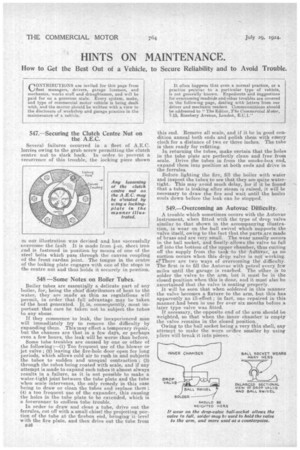HINTS ON MAINTENANCE.
Page 28

If you've noticed an error in this article please click here to report it so we can fix it.
Flow to Get the Best Out of a Vehicle, to Secure Reliability and to Avoid Trouble.
547.—Securing the Clutch Centre Nut on the A.E.C.
Several failures occurred in a fleet of A.E.C. lorries owing to the grub screw permitting the clutch centre nut to slack back. In order to prevent a recurrence of this trouble, the locking piece shown in our illustration was devised and has successfully
overcome the fault It is made from sheet iron and is fastened in position by mean e of one of the steel bolts which pass .through the canvas coupling of the front cardan joint. The tongue in the centre of the locking plate engages with one of the stops in the centre nut and thus bolds it securely in position.
548 —Some Notes on Boiler Tubes.
Boiler tubes are essentially a delicate part of any boiler, for, being the chief distributors of heat to the water, they are .made as thin as regulations will permit, in order that full advantage may be taken of the heat generated. 1t is, consequently, most important that care be taken not to subject the tubes to any abuse.
If they commence -to leak, the inexperienced Man will immediately try to remove the difficulty by expanding them. This may effect a temporary repair, but the chances are that in a few days, or perhaps even a few hours, the leak will be worse than before.
Some tube troubles are caused by one or other of the following :—(1) Too frequent use of the blower or jet valve ; (2) leaving the fire-hole door open for long periods, which allows cold air to rush in and subjects the tubes to sudden and unequal contraction ; (3) through the tubes being coated with scale, and if any attempt is made to expand such tubes it almost always results in a failure, as it is not possible to make a water-tight joint between the tube plate and the tube when scale intervenes, the only remedy in this case being to draw or clean the tubes and replace them ; (4) a too frequent use of the expander, this causing the holes in the tube plate to be extended, which is a forerunner to endless tube trouble.
In order to dra-w and clean a tube, drive out the ferrules, cut off with a small chisel the projecting portion of the tube at the firebox end, bringing it level with the fire plate, and then drive out the tube from
B46
this end. Remove all scale, and if it he in good condition anneal both ends and polish them with emery cloth for a distance of two or three inches. The tube is then ready for refitting.
In returning the tubes, make certain that the holes in-the tube plate are perfectly clean and free from scale. Drive the tubes in from the smoke-box end, expand them into position at both ends and drive in the ferrules.
Before lighting the fire, fill the boiler with water and inspect the tubes to see that they are quite watertight. This may avoid much delay, for if it be found that a tube is leaking after steam is raised, it will be necessary to draw the fire and wait until the boilet cools down before the leak can be stopped.
549.—Overcoming an Autovac Difficulty.
A trouble which sometimes occurs with the Autovac instrument, when fitted with the type of drop valve similar to -that shown in the accompanying illustration, is wear on the ball swivel which supports the valve itself, owing to the-fact that the. parts„are made of brass and are very small. The wear usually occurs in the ball socket, and finallyallows the valve to fall off into the bottom of the upper chamber, thus cutting off the supply from the tai* -to the AlitOvae, as no suction occurs when this dr6p valve is not working. ieThere are two ways of overcoming the difficulty. The first is to fill the Autovac with petrol every few miles until the garage is reached. The other IS to solder the valve to the arm, but it must be in the closed position when this is done, and it must also be ascertained that the valve is seating properly.
It will be seen that when soldered in this manner the valve becomes a fixture to the arm, but this has apparently no ill-effect ; in fact, one repaired in this manner.had been in use for over six months before a later type valve was fitted. If necessary, the opposite end of the arm should be weighted, so that when the inner chamber is empty the valve .remains in the closed position. Owing to the ball socket being a very thin shell, any attempt to make the worn orifice smaller by using pliers will break it into pieces.






























